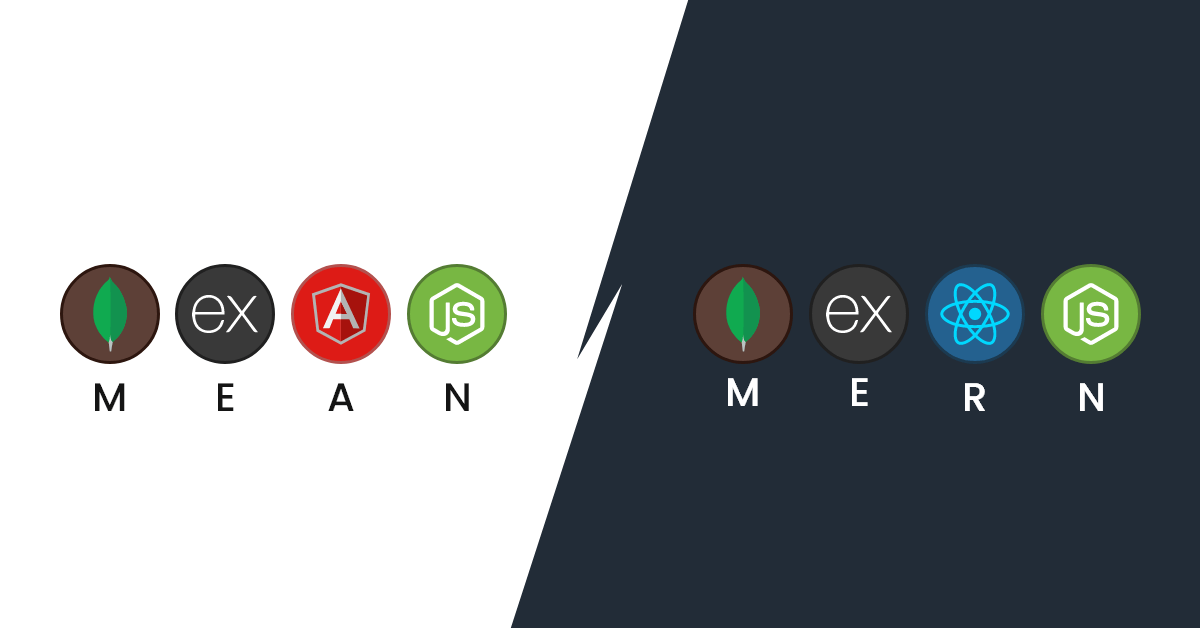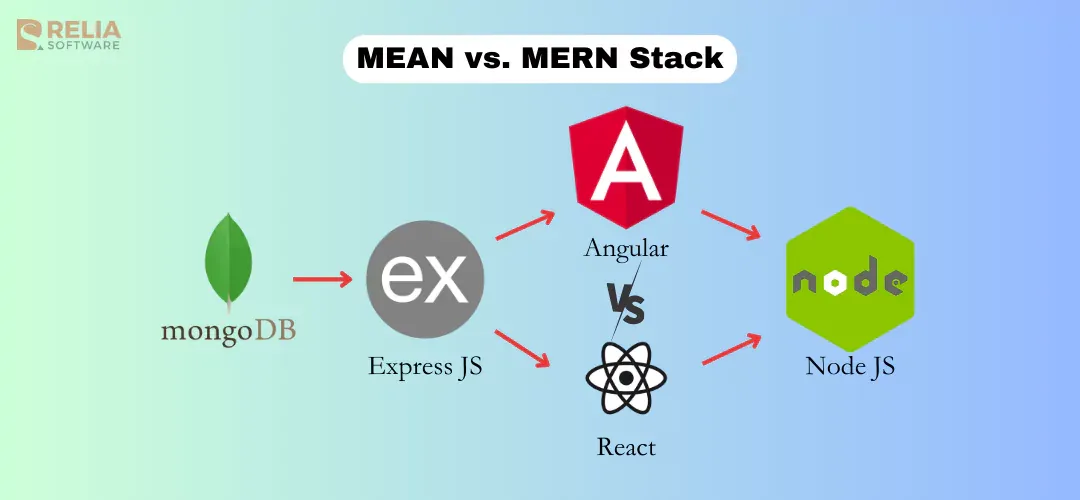Building a strong and engaging web application is critical for success in today's fast-paced business environment. Choosing the appropriate technology stack is an important initial step, and two outstanding possibilities are MEAN and MERN. This comprehensive guide will examine a detailed comparison of the MEAN stack vs. MERN stack, including their similarities, differences, and when to use these two stacks.
Similarity Of MERN & MEAN Stack
Backend Technologies
MERN stack and MEAN stack both depend on the powerful combination of MongoDB and Express.js. MongoDB, a type of NoSQL database, provides a high degree of flexibility and adaptability for storing and managing your project's data.
On the other hand, Express.js is a lean JavaScript web framework constructed on top of Node.js. It offers a robust base for creating efficient APIs and managing server-side functionality. This common backend technology guarantees a strong and effective base for your application.
JavaScript Language
Both MERN and MEAN frameworks mainly rely on JavaScript, making them well-suited for developers who are already proficient in this adaptable programming language. The uniform language used in both the front-end and back-end enables the reuse of code, minimizing the requirement for extra languages and fostering a cohesive development process by utilizing shared frameworks and libraries throughout the codebase.
Full-Stack Development
MERN and MEAN stacks have a significant advantage in their capability to manage the complete software development lifecycle. These stacks provide a comprehensive solution within a single ecosystem. It encompasses tasks such as creating user interfaces using front-end development tools and managing databases and server-side logic (back-end development). This simplifies project management, optimizes development processes, and promotes a more integrated workflow for your team.
Open-Source Nature
MERN & MEAN, they are all characterized by their open-source nature. This indicates that they are easily available, free of charge, and continuously advancing due to the input from an active group of developers.
This open-source platform promotes creativity, guarantees continuous progress, and offers a wide range of resources and assistance for developers utilizing either stack. It is usually via version control systems like Git, with publicly accessible repositories, where developers can duplicate the codebase, make modifications, and propose pull requests for integration.

Differences Between MERN Stack vs MEAN Stack
Front-end Framework
MERN
In MERN, React, on the other hand, takes a more adaptable approach to creating UIs. It functions as a JavaScript library rather than a complete framework, and provides the following important benefits:
- Gradual Learning Curve: Beginners can learn React's component-based architecture with basic JavaScript expertise.
- Reusability: React uses props to pass data. It also states management solutions like Redux or Context API to build reusable UI components, which speeds up development.
- Virtual DOM: This allows React to create highly dynamic and interactive UIs, making it ideal for continual user engagement in modern web apps.
MEAN
Angular is a complete JavaScript framework for MEAN that requires a clear, component-based architecture. This organized method provides various benefits, especially for large-scale enterprise applications:
- Better Maintainability: Modules, services, and dependency injection make Angular's code architecture easier to manage, which decreases project errors as it increases.
- Development Predictability: Angular's clean structure makes development predictable. Directives and a well-defined component hierarchy help teams interact and onboard new development.
- Data Binding Power: Two-way data binding in Angular automatically synchronizes UI and model data, which streamlines data-driven app development.

>> Read more:
- React vs Angular: What is the difference?
- Top 7 Popular Approaches for State Management in Angular
Skills and Learning Curve
MERN
Beginners find React's component-based architecture and JavaScript skills easier to learn than Angular. Front-end developers and those who need to quickly design UI prototypes may benefit from this. However, React's lack of structure can lead to a more complex codebase that demands a deeper understanding of JavaScript design patterns and state management solutions like Redux or Context API for larger projects.
>> Read more: A Complete Guide to Hire Dedicated ReactJS Developers
MEAN
Developers who are unfamiliar with the Angular framework may need to invest more in its structured approach and unique features like directives and dependency injection. After that initial obstacle, Angular's structure and predictability can simplify development and improve code maintainability, especially for complex projects. The abundance of Angular tutorials and documentation can also help with the learning curve.
>> Read more: Step-by-Step Guide to Hire Angular Developers for Businesses

Architecture and Productivity
MERN
The MERN stack, on the other hand, adopts a more flexible approach. The front-end framework with React in MERN utilizes a component-based architecture but without the rigid structure of Angular. This flexibility offers distinct benefits:
- Faster Development Cycles: Simpler projects with fewer teams can use a looser MVC structure for faster UI prototyping and initial development cycles.
- Highly Customisable: The flexibility of React lets developers tailor their projects' application architecture. Custom hooks and flexible routing can assist in creating unique user experiences and integrate third-party frameworks. This flexibility might result in more complex codebases that require more integration testing and maintainability tools for large projects.
MEAN
The MEAN stack follows a clearly defined Model-View-Controller (MVC) design. Angular, the front-end framework, requires a component-based architecture that facilitates code organization, and maintainability through functionalities such as modules and services, and simplifies unit testing. The utilization of this methodical technique presents numerous benefits:
- Clear Separation of Concerns: MVC architecture layers application logic (Model), user interface (View), and user interactions (Controller). complicated projects with complicated data flow and UIs benefit from code reuse and maintenance.
- Defined Structure: Angular's defined structure and MEAN's MVC design make development predictable and clear by separating concerns. This simplifies development team collaboration, onboarding new developers, and code consistency.
Performance & Scalability
MERN
The virtual DOM and component-based rendering of React improve performance, especially for dynamic UIs. React solely re-renders changed components, reducing DOM operations and boosting responsiveness. MERN applications with complicated state management solutions may need careful optimization to prevent performance bottlenecks.
Maintaining a clean and scalable codebase requires developer best practices and possibly additional tooling as React doesn't enforce code organisation. Node.js' horizontal scalability lets you add servers to share processing power as user traffic rises. MongoDB and MEAN allow horizontal data storage scalability.
MEAN
Well-optimized apps can benefit from MEAN's organized architecture and Angular's clear separation of responsibilities and rapid data binding. Angular's two-way data binding may slow responsiveness under large loads in highly dynamic UIs with frequent updates.
Services in Angular and well-defined directories in Express make MEAN modular and code-friendly. This gets more beneficial when apps and codebases develop. MongoDB's horizontal scalability lets you add servers to meet data storage needs.

Error Handling and Security
MERN
React doesn't have any built-in ways to handle errors. However, developers can use React libraries and tools like Redux or React Query to make error handling and state management more robust. These tools can make debugging easier by offering features like centralized error handling and state management. The way that errors are handled in Node.js and Express.js is similar to MEAN. Middleware gives developers more options for how to handle exceptions. For data security, MERN apps can also use MongoDB's RBAC.
MEAN
Angular requires dependency injection, which encourages a modular method that can help keep errors separate and stop problems from spreading. Express.js also has middleware for error handling that lets writers set up their logic for gracefully handling exceptions. For strong error handling, developers can also use extra libraries that offer features like full logging and systems for handling exceptions. Role-based access control (RBAC) lets you control who can see what data is in your application using MongoDB.

When To Choose MERN Stack?
Single-Page Applications (SPAs): MERN is a great choice for making SPAs that focus on giving users a smooth and flexible experience. React's component-based design lets you make UI parts that can be used repeatedly, which can speed up the development process for SPAs.
Social Media Apps: Because MERN is flexible and focuses on UI components, it's a good choice for making social media apps that need to be updated often and look modern. Popular front-end tools that can improve the look and feel of social media apps can be used with MERN because it focuses on JavaScript across the stack.
Real-Time Applications: Because MERN focuses on JavaScript across the stack, it's easy to connect to real-time communication tools. This makes it a good choice for creating real-time apps like chat or collaborative editing tools. Adding real-time contact features can be made easier if the codebase is shared across the stack.
When To Choose MEAN Stack?
Enterprise Apps: These complex web apps with intricate information models and UIs need maintainability and scalability. The structured design and modular parts of MEAN make it easy to manage large codebases in these business projects.
Internal Business Tools: Applications for structured development and readily available learning resources in organizations. Because MEAN focuses on organizing code and has a lot of community resources, it works well for internal tools.
E-commerce Platforms: MEAN is suitable for feature-rich e-commerce apps that prioritize structured development and long-term maintainability. Because MEAN is made up of modules, it can help e-commerce platforms handle their growing complexity as they add more features and functions.

>> Read more:
- Next.js vs React: How to Choose the Right Framework?
- Next.js vs Angular: What Are The Differences?
- A Comprehensive Guide to MEVN Stack Development
Conclusion
The MERN and MEAN stacks each have their benefits. MEAN works great for complex business apps that need a structured and easy-to-maintain codebase. For projects that need to grow quickly, be flexible, and give users new experiences all the time, MERN might be a better choice. Keep in mind things like the project's difficulty, the team's skills, the speed at which you want to develop it, and how easy it will be to maintain in the long run. Hope this blog informs you about the differences between MEAN stack vs MERN stack.
>>> Follow and Contact Relia Software for more information!
- development

